Quantitative Methods in Nursing Research: Jordan Hospital Study
VerifiedAdded on 2023/01/17
|12
|2859
|41
Report
AI Summary
This report presents a comprehensive analysis of quantitative research methods applied to a study on healthcare professionals' resistance to Electronic Medical Records (EMRs) in public sector hospitals in Jordan. The research design employs a cross-sectional quantitative approach, utilizing questionnaires distributed to doctors and medical professionals via random sampling. The study aims to assess the influence of independent variables like computer self-efficacy (CSE), perceived complexity (PC), and attitude towards EMR systems (ATE), along with anxiety, on the dependent variable of EMR resistance. The methodology includes power analysis to determine the optimal sample size and the use of statistical tools such as correlation and regression analysis to determine the relationship between variables. The report details the variables considered, including independent variables (CSE, PC, ATE, anxiety) and dependent variables (EMR resistance), alongside demographic indicators. It outlines the measures used, emphasizing statistical tools like mean, standard deviation, and regression analysis, along with data collection methods involving questionnaires and online surveys. The data analysis section highlights the application of statistical tools like SPSS and the use of correlation and regression analysis. The report also addresses study limitations, including selection bias, incomplete data, and potential threats to reliability and validity, along with anticipated problems and their potential solutions. Finally, the report concludes with a discussion of data analysis methods and the implications of the findings for EMR implementation in healthcare settings.
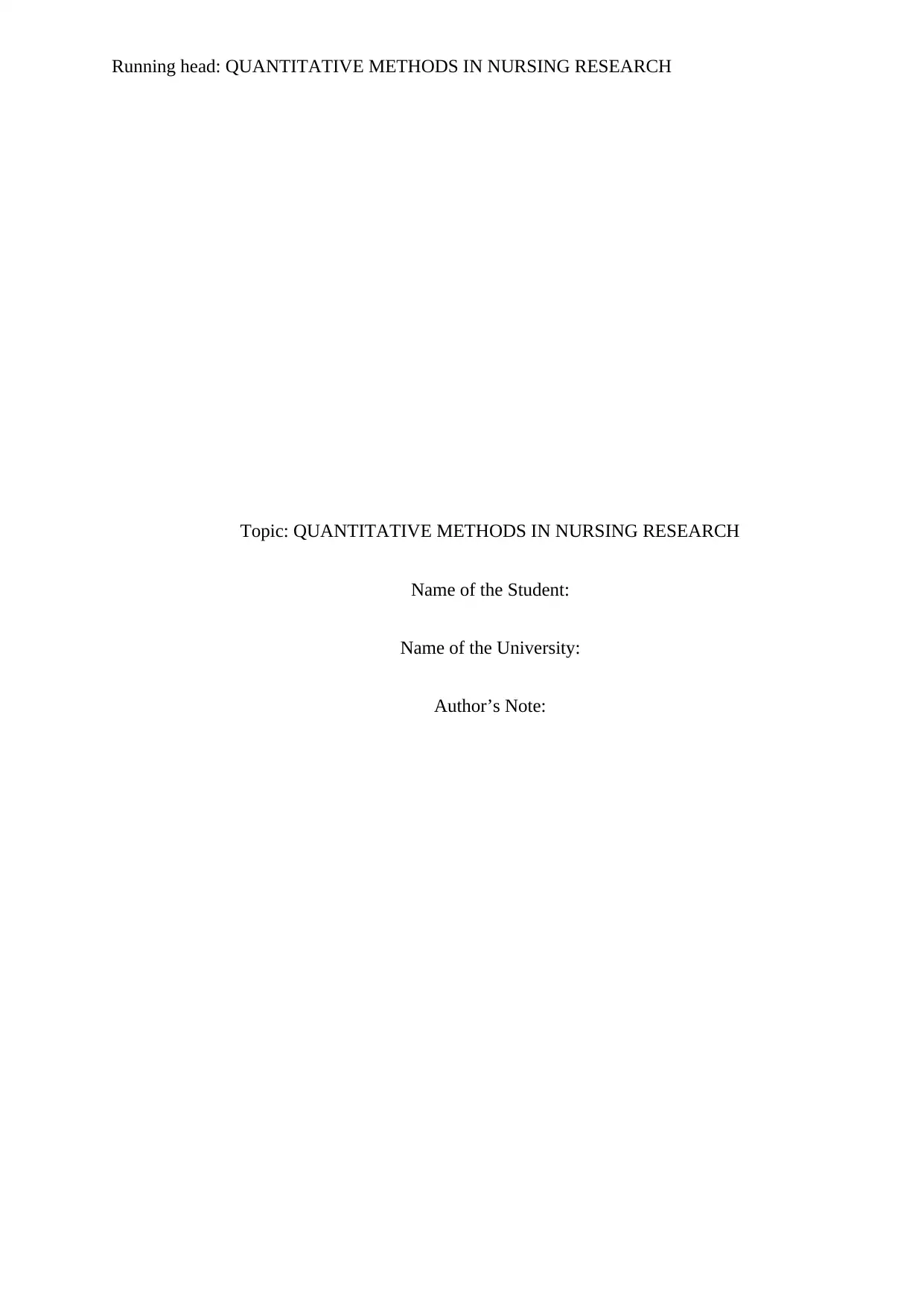
Running head: QUANTITATIVE METHODS IN NURSING RESEARCH
Topic: QUANTITATIVE METHODS IN NURSING RESEARCH
Name of the Student:
Name of the University:
Author’s Note:
Topic: QUANTITATIVE METHODS IN NURSING RESEARCH
Name of the Student:
Name of the University:
Author’s Note:
Paraphrase This Document
Need a fresh take? Get an instant paraphrase of this document with our AI Paraphraser
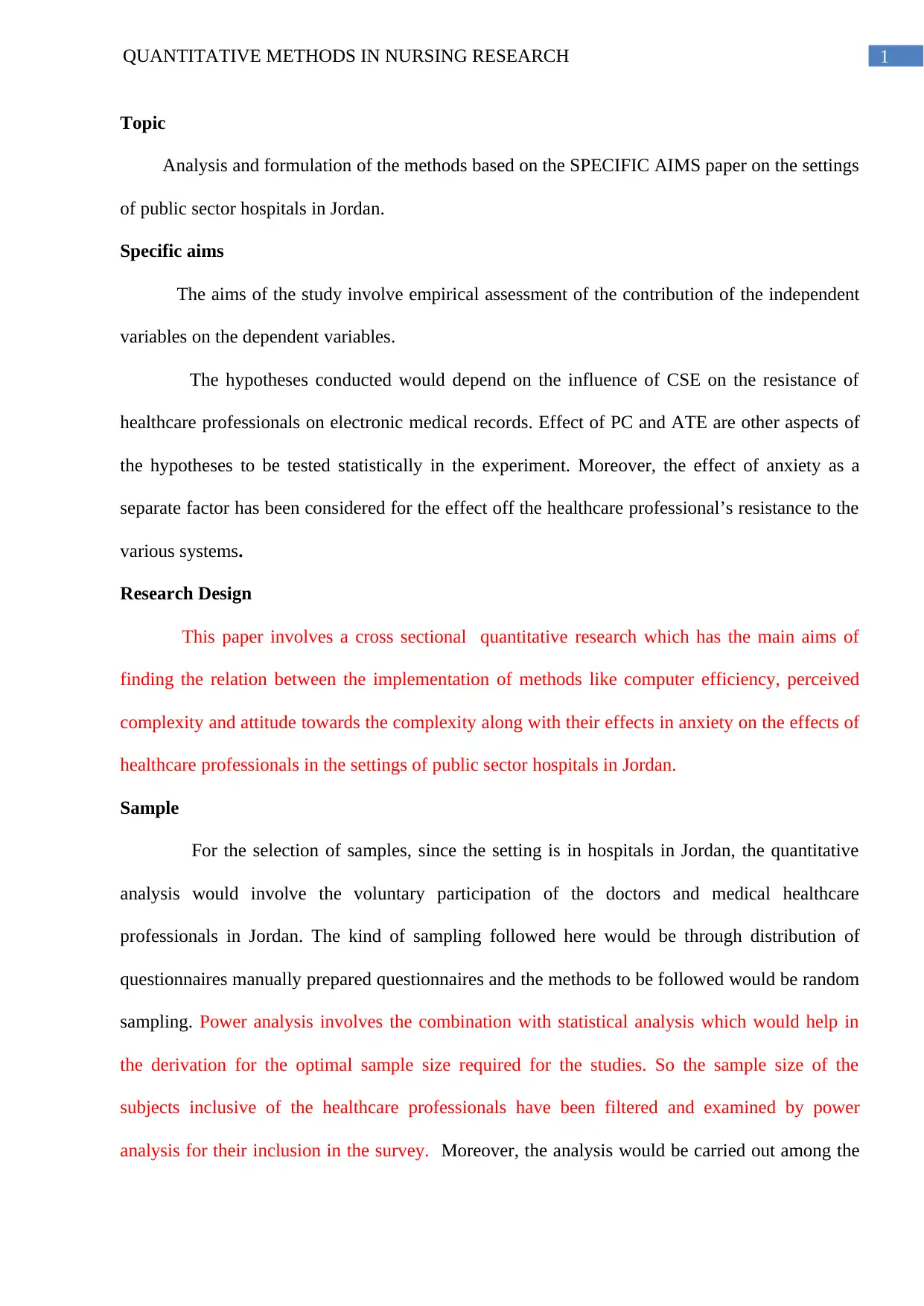
1QUANTITATIVE METHODS IN NURSING RESEARCH
Topic
Analysis and formulation of the methods based on the SPECIFIC AIMS paper on the settings
of public sector hospitals in Jordan.
Specific aims
The aims of the study involve empirical assessment of the contribution of the independent
variables on the dependent variables.
The hypotheses conducted would depend on the influence of CSE on the resistance of
healthcare professionals on electronic medical records. Effect of PC and ATE are other aspects of
the hypotheses to be tested statistically in the experiment. Moreover, the effect of anxiety as a
separate factor has been considered for the effect off the healthcare professional’s resistance to the
various systems.
Research Design
This paper involves a cross sectional quantitative research which has the main aims of
finding the relation between the implementation of methods like computer efficiency, perceived
complexity and attitude towards the complexity along with their effects in anxiety on the effects of
healthcare professionals in the settings of public sector hospitals in Jordan.
Sample
For the selection of samples, since the setting is in hospitals in Jordan, the quantitative
analysis would involve the voluntary participation of the doctors and medical healthcare
professionals in Jordan. The kind of sampling followed here would be through distribution of
questionnaires manually prepared questionnaires and the methods to be followed would be random
sampling. Power analysis involves the combination with statistical analysis which would help in
the derivation for the optimal sample size required for the studies. So the sample size of the
subjects inclusive of the healthcare professionals have been filtered and examined by power
analysis for their inclusion in the survey. Moreover, the analysis would be carried out among the
Topic
Analysis and formulation of the methods based on the SPECIFIC AIMS paper on the settings
of public sector hospitals in Jordan.
Specific aims
The aims of the study involve empirical assessment of the contribution of the independent
variables on the dependent variables.
The hypotheses conducted would depend on the influence of CSE on the resistance of
healthcare professionals on electronic medical records. Effect of PC and ATE are other aspects of
the hypotheses to be tested statistically in the experiment. Moreover, the effect of anxiety as a
separate factor has been considered for the effect off the healthcare professional’s resistance to the
various systems.
Research Design
This paper involves a cross sectional quantitative research which has the main aims of
finding the relation between the implementation of methods like computer efficiency, perceived
complexity and attitude towards the complexity along with their effects in anxiety on the effects of
healthcare professionals in the settings of public sector hospitals in Jordan.
Sample
For the selection of samples, since the setting is in hospitals in Jordan, the quantitative
analysis would involve the voluntary participation of the doctors and medical healthcare
professionals in Jordan. The kind of sampling followed here would be through distribution of
questionnaires manually prepared questionnaires and the methods to be followed would be random
sampling. Power analysis involves the combination with statistical analysis which would help in
the derivation for the optimal sample size required for the studies. So the sample size of the
subjects inclusive of the healthcare professionals have been filtered and examined by power
analysis for their inclusion in the survey. Moreover, the analysis would be carried out among the

2QUANTITATIVE METHODS IN NURSING RESEARCH
various sectors of health care professional including nurses. Voluntary participation of the health
care professionals would be considered. The questions would be open ended in the following
survey. Moreover, questionnaires would be distributed through online systems where the staffs and
related professionals of the hospital would have to complete the form for participating in the
survey. The various sources of quantitative research methods would be participant observation
along with the analysis of the results of the interviews. This would be followed by determination of
the correlation between the various variables calculated through statistical tools inclusive of the
determination of level of significance between the variables. Correlation and regression analysis
would be useful for the determination of dependence between the two variables and analysis of
their relation (Harrel, 2015).
Variables
The predictors of the study have been the factors involved with the resistance of health care
professional to EMR. These predictors could help researchers with the indication of focussing on
specific research attention for obtaining better information on the roots of resistance and the way
of possible solutions. Independent variables are also known as predictor variables. They are the
variables which are being manipulated for an experiment for observation of the effects of
dependent variables often known as outcome variables (Kim, 2015). Computer self-efficacy (CSE)
is a kind of electronic medical records which is considered to be the perception of an individual
based on the ability of using computers. Moreover, Perceived complexity (PC) and the attitude
towards the EMR systems (ATE) can be the factors acting as barriers to the problem. Thus in the
following study various dependent and independent variables have been taken into consideration
for finding the relation and regression between the various variable. The dependent variables are
the resistance of the EMR systems to the work of the healthcare professionals. Moreover,
independent variables would be considered as the effects of CSE, PC, ATE as well as anxiety.
Age, gender, healthcare and the years of being engaged in use of computers have been considered
various sectors of health care professional including nurses. Voluntary participation of the health
care professionals would be considered. The questions would be open ended in the following
survey. Moreover, questionnaires would be distributed through online systems where the staffs and
related professionals of the hospital would have to complete the form for participating in the
survey. The various sources of quantitative research methods would be participant observation
along with the analysis of the results of the interviews. This would be followed by determination of
the correlation between the various variables calculated through statistical tools inclusive of the
determination of level of significance between the variables. Correlation and regression analysis
would be useful for the determination of dependence between the two variables and analysis of
their relation (Harrel, 2015).
Variables
The predictors of the study have been the factors involved with the resistance of health care
professional to EMR. These predictors could help researchers with the indication of focussing on
specific research attention for obtaining better information on the roots of resistance and the way
of possible solutions. Independent variables are also known as predictor variables. They are the
variables which are being manipulated for an experiment for observation of the effects of
dependent variables often known as outcome variables (Kim, 2015). Computer self-efficacy (CSE)
is a kind of electronic medical records which is considered to be the perception of an individual
based on the ability of using computers. Moreover, Perceived complexity (PC) and the attitude
towards the EMR systems (ATE) can be the factors acting as barriers to the problem. Thus in the
following study various dependent and independent variables have been taken into consideration
for finding the relation and regression between the various variable. The dependent variables are
the resistance of the EMR systems to the work of the healthcare professionals. Moreover,
independent variables would be considered as the effects of CSE, PC, ATE as well as anxiety.
Age, gender, healthcare and the years of being engaged in use of computers have been considered
⊘ This is a preview!⊘
Do you want full access?
Subscribe today to unlock all pages.

Trusted by 1+ million students worldwide
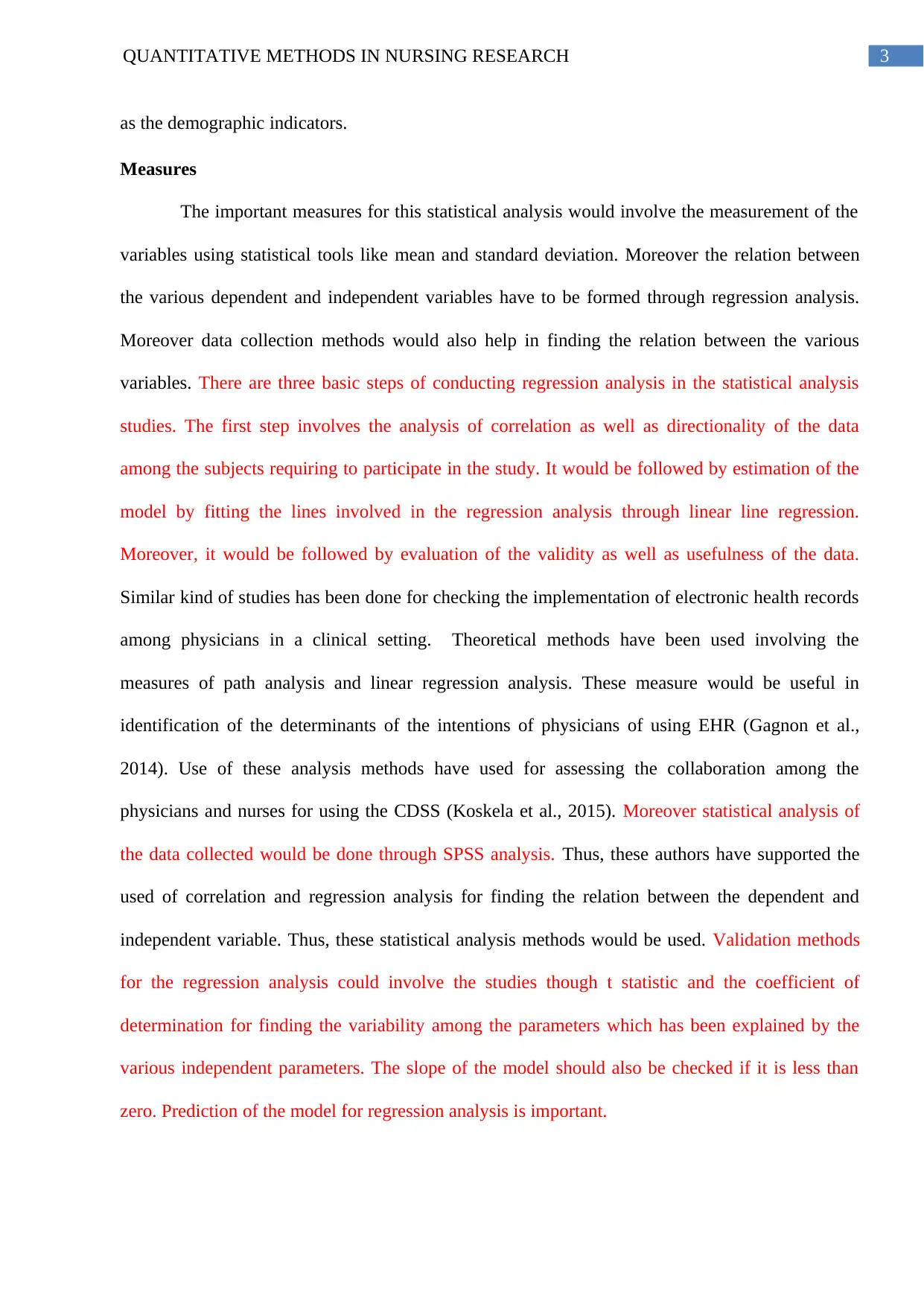
3QUANTITATIVE METHODS IN NURSING RESEARCH
as the demographic indicators.
Measures
The important measures for this statistical analysis would involve the measurement of the
variables using statistical tools like mean and standard deviation. Moreover the relation between
the various dependent and independent variables have to be formed through regression analysis.
Moreover data collection methods would also help in finding the relation between the various
variables. There are three basic steps of conducting regression analysis in the statistical analysis
studies. The first step involves the analysis of correlation as well as directionality of the data
among the subjects requiring to participate in the study. It would be followed by estimation of the
model by fitting the lines involved in the regression analysis through linear line regression.
Moreover, it would be followed by evaluation of the validity as well as usefulness of the data.
Similar kind of studies has been done for checking the implementation of electronic health records
among physicians in a clinical setting. Theoretical methods have been used involving the
measures of path analysis and linear regression analysis. These measure would be useful in
identification of the determinants of the intentions of physicians of using EHR (Gagnon et al.,
2014). Use of these analysis methods have used for assessing the collaboration among the
physicians and nurses for using the CDSS (Koskela et al., 2015). Moreover statistical analysis of
the data collected would be done through SPSS analysis. Thus, these authors have supported the
used of correlation and regression analysis for finding the relation between the dependent and
independent variable. Thus, these statistical analysis methods would be used. Validation methods
for the regression analysis could involve the studies though t statistic and the coefficient of
determination for finding the variability among the parameters which has been explained by the
various independent parameters. The slope of the model should also be checked if it is less than
zero. Prediction of the model for regression analysis is important.
as the demographic indicators.
Measures
The important measures for this statistical analysis would involve the measurement of the
variables using statistical tools like mean and standard deviation. Moreover the relation between
the various dependent and independent variables have to be formed through regression analysis.
Moreover data collection methods would also help in finding the relation between the various
variables. There are three basic steps of conducting regression analysis in the statistical analysis
studies. The first step involves the analysis of correlation as well as directionality of the data
among the subjects requiring to participate in the study. It would be followed by estimation of the
model by fitting the lines involved in the regression analysis through linear line regression.
Moreover, it would be followed by evaluation of the validity as well as usefulness of the data.
Similar kind of studies has been done for checking the implementation of electronic health records
among physicians in a clinical setting. Theoretical methods have been used involving the
measures of path analysis and linear regression analysis. These measure would be useful in
identification of the determinants of the intentions of physicians of using EHR (Gagnon et al.,
2014). Use of these analysis methods have used for assessing the collaboration among the
physicians and nurses for using the CDSS (Koskela et al., 2015). Moreover statistical analysis of
the data collected would be done through SPSS analysis. Thus, these authors have supported the
used of correlation and regression analysis for finding the relation between the dependent and
independent variable. Thus, these statistical analysis methods would be used. Validation methods
for the regression analysis could involve the studies though t statistic and the coefficient of
determination for finding the variability among the parameters which has been explained by the
various independent parameters. The slope of the model should also be checked if it is less than
zero. Prediction of the model for regression analysis is important.
Paraphrase This Document
Need a fresh take? Get an instant paraphrase of this document with our AI Paraphraser

4QUANTITATIVE METHODS IN NURSING RESEARCH
Procedure
The data collection methods would be the first step of this statistical procedure where a
quantitative analysis would be done on the basis of the survey conducted among the healthcare
professions in the hospitals of Jordan using manually prepared open-ended questionnaires. The
questionnaire would be distributed through online sources along with various distribution
procedures like pamphlets and interview among the hospital settings. There would be voluntary
participation of the people involved and random statistical sampling have to be done during the
consideration of the sample solution. The data collection process would be followed by extensive
filtering where the exclusion criteria would be imposed and the papers would be selected based on
the selection criteria. Incomplete questionnaires would be not considered or rejected. Now the
filtered data would be considered for data analysis methods where analysis would be done on the
basis of the relations between the dependent and the independent through linear regression analysis
which can be done for finding the significance of the EMRs of the hospital process of the medical
professionals. Moreover, correlation and regression analysis studies can be done to find the effect
of the variables on the various factors taking the predictors into consideration.
Data analysis
According to the studies of Boonsra, Versluis & Vos (2014), implementation of electronic
health records have been used in the hospital. The systematic literature review have found that
there has been a positive effects on the various performance of the hospitals along within
implementation of complex understanding. Three systems like the EHR context, EHR content,
EHR implementation processes have been taken into account for the study. The data collection
methods has been on the use of databases like EBSCO, Cochrane library and Web of Knowledge.
Similarly studies carried out by the review of the electronic medical methods and the electronic
health records on the basis of interface usability issues. Here also a literature search or systematic
review has based done of the basis of tools like PubMed, CINAHL, Compendex, and Web of
Procedure
The data collection methods would be the first step of this statistical procedure where a
quantitative analysis would be done on the basis of the survey conducted among the healthcare
professions in the hospitals of Jordan using manually prepared open-ended questionnaires. The
questionnaire would be distributed through online sources along with various distribution
procedures like pamphlets and interview among the hospital settings. There would be voluntary
participation of the people involved and random statistical sampling have to be done during the
consideration of the sample solution. The data collection process would be followed by extensive
filtering where the exclusion criteria would be imposed and the papers would be selected based on
the selection criteria. Incomplete questionnaires would be not considered or rejected. Now the
filtered data would be considered for data analysis methods where analysis would be done on the
basis of the relations between the dependent and the independent through linear regression analysis
which can be done for finding the significance of the EMRs of the hospital process of the medical
professionals. Moreover, correlation and regression analysis studies can be done to find the effect
of the variables on the various factors taking the predictors into consideration.
Data analysis
According to the studies of Boonsra, Versluis & Vos (2014), implementation of electronic
health records have been used in the hospital. The systematic literature review have found that
there has been a positive effects on the various performance of the hospitals along within
implementation of complex understanding. Three systems like the EHR context, EHR content,
EHR implementation processes have been taken into account for the study. The data collection
methods has been on the use of databases like EBSCO, Cochrane library and Web of Knowledge.
Similarly studies carried out by the review of the electronic medical methods and the electronic
health records on the basis of interface usability issues. Here also a literature search or systematic
review has based done of the basis of tools like PubMed, CINAHL, Compendex, and Web of
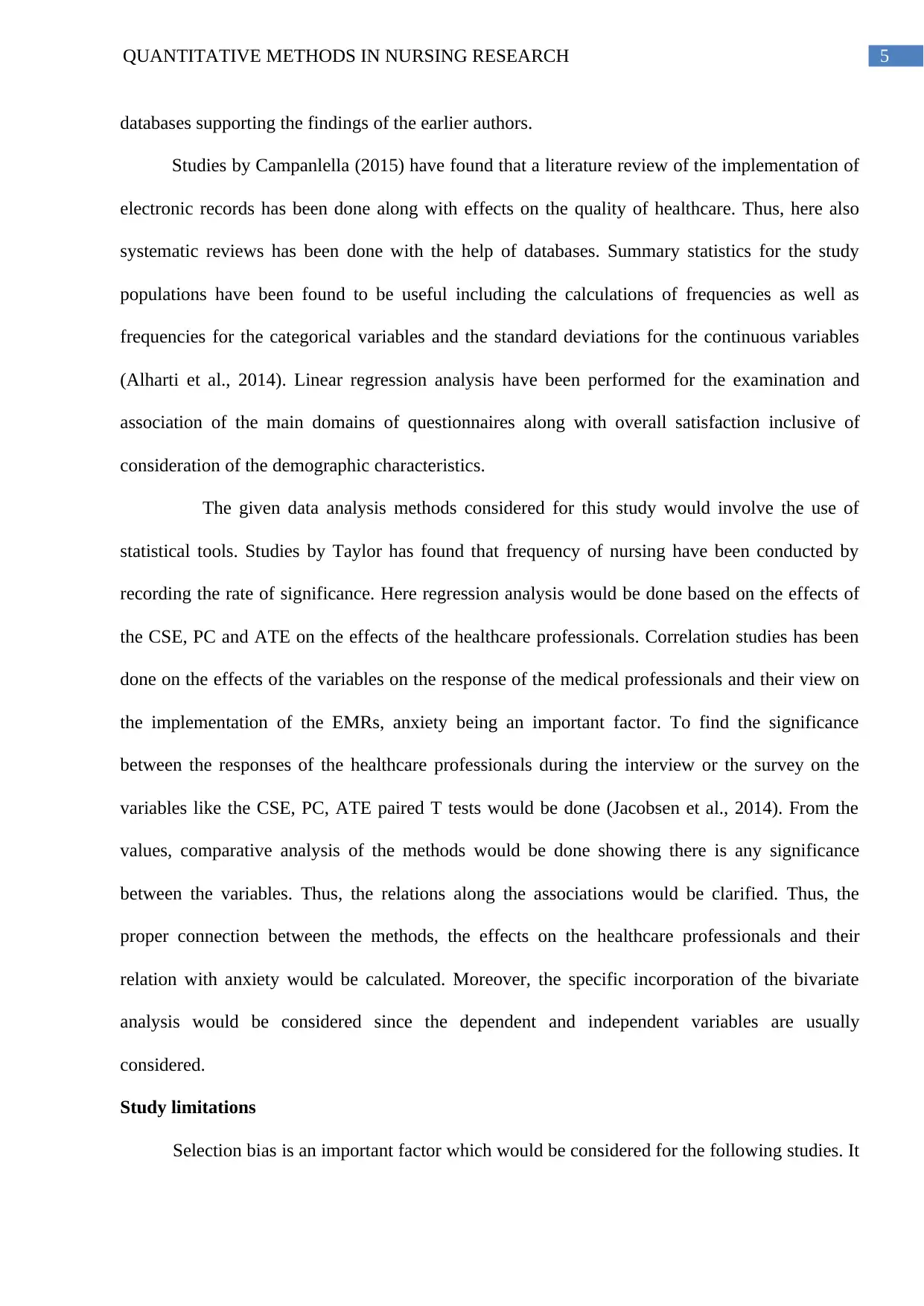
5QUANTITATIVE METHODS IN NURSING RESEARCH
databases supporting the findings of the earlier authors.
Studies by Campanlella (2015) have found that a literature review of the implementation of
electronic records has been done along with effects on the quality of healthcare. Thus, here also
systematic reviews has been done with the help of databases. Summary statistics for the study
populations have been found to be useful including the calculations of frequencies as well as
frequencies for the categorical variables and the standard deviations for the continuous variables
(Alharti et al., 2014). Linear regression analysis have been performed for the examination and
association of the main domains of questionnaires along with overall satisfaction inclusive of
consideration of the demographic characteristics.
The given data analysis methods considered for this study would involve the use of
statistical tools. Studies by Taylor has found that frequency of nursing have been conducted by
recording the rate of significance. Here regression analysis would be done based on the effects of
the CSE, PC and ATE on the effects of the healthcare professionals. Correlation studies has been
done on the effects of the variables on the response of the medical professionals and their view on
the implementation of the EMRs, anxiety being an important factor. To find the significance
between the responses of the healthcare professionals during the interview or the survey on the
variables like the CSE, PC, ATE paired T tests would be done (Jacobsen et al., 2014). From the
values, comparative analysis of the methods would be done showing there is any significance
between the variables. Thus, the relations along the associations would be clarified. Thus, the
proper connection between the methods, the effects on the healthcare professionals and their
relation with anxiety would be calculated. Moreover, the specific incorporation of the bivariate
analysis would be considered since the dependent and independent variables are usually
considered.
Study limitations
Selection bias is an important factor which would be considered for the following studies. It
databases supporting the findings of the earlier authors.
Studies by Campanlella (2015) have found that a literature review of the implementation of
electronic records has been done along with effects on the quality of healthcare. Thus, here also
systematic reviews has been done with the help of databases. Summary statistics for the study
populations have been found to be useful including the calculations of frequencies as well as
frequencies for the categorical variables and the standard deviations for the continuous variables
(Alharti et al., 2014). Linear regression analysis have been performed for the examination and
association of the main domains of questionnaires along with overall satisfaction inclusive of
consideration of the demographic characteristics.
The given data analysis methods considered for this study would involve the use of
statistical tools. Studies by Taylor has found that frequency of nursing have been conducted by
recording the rate of significance. Here regression analysis would be done based on the effects of
the CSE, PC and ATE on the effects of the healthcare professionals. Correlation studies has been
done on the effects of the variables on the response of the medical professionals and their view on
the implementation of the EMRs, anxiety being an important factor. To find the significance
between the responses of the healthcare professionals during the interview or the survey on the
variables like the CSE, PC, ATE paired T tests would be done (Jacobsen et al., 2014). From the
values, comparative analysis of the methods would be done showing there is any significance
between the variables. Thus, the relations along the associations would be clarified. Thus, the
proper connection between the methods, the effects on the healthcare professionals and their
relation with anxiety would be calculated. Moreover, the specific incorporation of the bivariate
analysis would be considered since the dependent and independent variables are usually
considered.
Study limitations
Selection bias is an important factor which would be considered for the following studies. It
⊘ This is a preview!⊘
Do you want full access?
Subscribe today to unlock all pages.

Trusted by 1+ million students worldwide
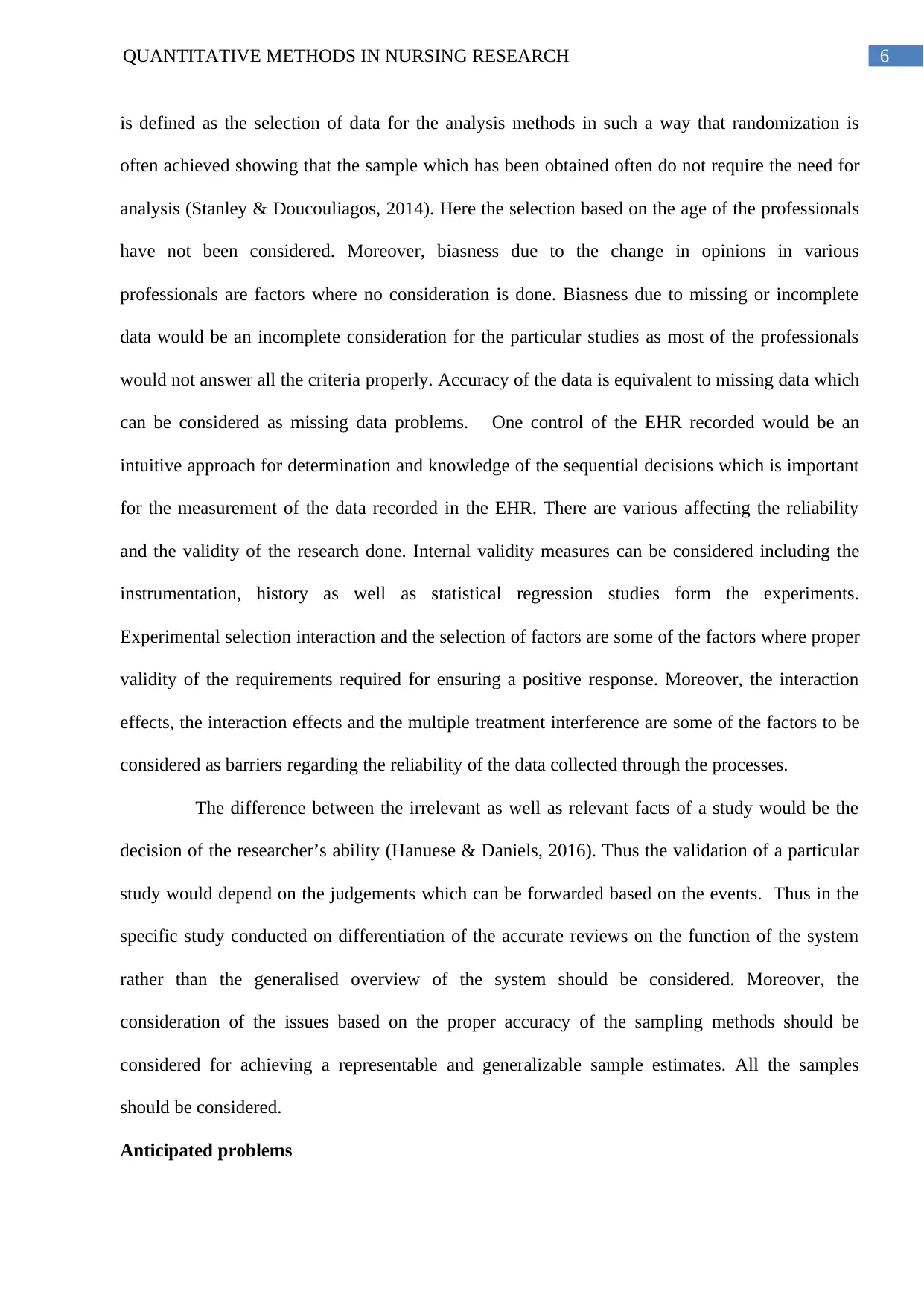
6QUANTITATIVE METHODS IN NURSING RESEARCH
is defined as the selection of data for the analysis methods in such a way that randomization is
often achieved showing that the sample which has been obtained often do not require the need for
analysis (Stanley & Doucouliagos, 2014). Here the selection based on the age of the professionals
have not been considered. Moreover, biasness due to the change in opinions in various
professionals are factors where no consideration is done. Biasness due to missing or incomplete
data would be an incomplete consideration for the particular studies as most of the professionals
would not answer all the criteria properly. Accuracy of the data is equivalent to missing data which
can be considered as missing data problems. One control of the EHR recorded would be an
intuitive approach for determination and knowledge of the sequential decisions which is important
for the measurement of the data recorded in the EHR. There are various affecting the reliability
and the validity of the research done. Internal validity measures can be considered including the
instrumentation, history as well as statistical regression studies form the experiments.
Experimental selection interaction and the selection of factors are some of the factors where proper
validity of the requirements required for ensuring a positive response. Moreover, the interaction
effects, the interaction effects and the multiple treatment interference are some of the factors to be
considered as barriers regarding the reliability of the data collected through the processes.
The difference between the irrelevant as well as relevant facts of a study would be the
decision of the researcher’s ability (Hanuese & Daniels, 2016). Thus the validation of a particular
study would depend on the judgements which can be forwarded based on the events. Thus in the
specific study conducted on differentiation of the accurate reviews on the function of the system
rather than the generalised overview of the system should be considered. Moreover, the
consideration of the issues based on the proper accuracy of the sampling methods should be
considered for achieving a representable and generalizable sample estimates. All the samples
should be considered.
Anticipated problems
is defined as the selection of data for the analysis methods in such a way that randomization is
often achieved showing that the sample which has been obtained often do not require the need for
analysis (Stanley & Doucouliagos, 2014). Here the selection based on the age of the professionals
have not been considered. Moreover, biasness due to the change in opinions in various
professionals are factors where no consideration is done. Biasness due to missing or incomplete
data would be an incomplete consideration for the particular studies as most of the professionals
would not answer all the criteria properly. Accuracy of the data is equivalent to missing data which
can be considered as missing data problems. One control of the EHR recorded would be an
intuitive approach for determination and knowledge of the sequential decisions which is important
for the measurement of the data recorded in the EHR. There are various affecting the reliability
and the validity of the research done. Internal validity measures can be considered including the
instrumentation, history as well as statistical regression studies form the experiments.
Experimental selection interaction and the selection of factors are some of the factors where proper
validity of the requirements required for ensuring a positive response. Moreover, the interaction
effects, the interaction effects and the multiple treatment interference are some of the factors to be
considered as barriers regarding the reliability of the data collected through the processes.
The difference between the irrelevant as well as relevant facts of a study would be the
decision of the researcher’s ability (Hanuese & Daniels, 2016). Thus the validation of a particular
study would depend on the judgements which can be forwarded based on the events. Thus in the
specific study conducted on differentiation of the accurate reviews on the function of the system
rather than the generalised overview of the system should be considered. Moreover, the
consideration of the issues based on the proper accuracy of the sampling methods should be
considered for achieving a representable and generalizable sample estimates. All the samples
should be considered.
Anticipated problems
Paraphrase This Document
Need a fresh take? Get an instant paraphrase of this document with our AI Paraphraser
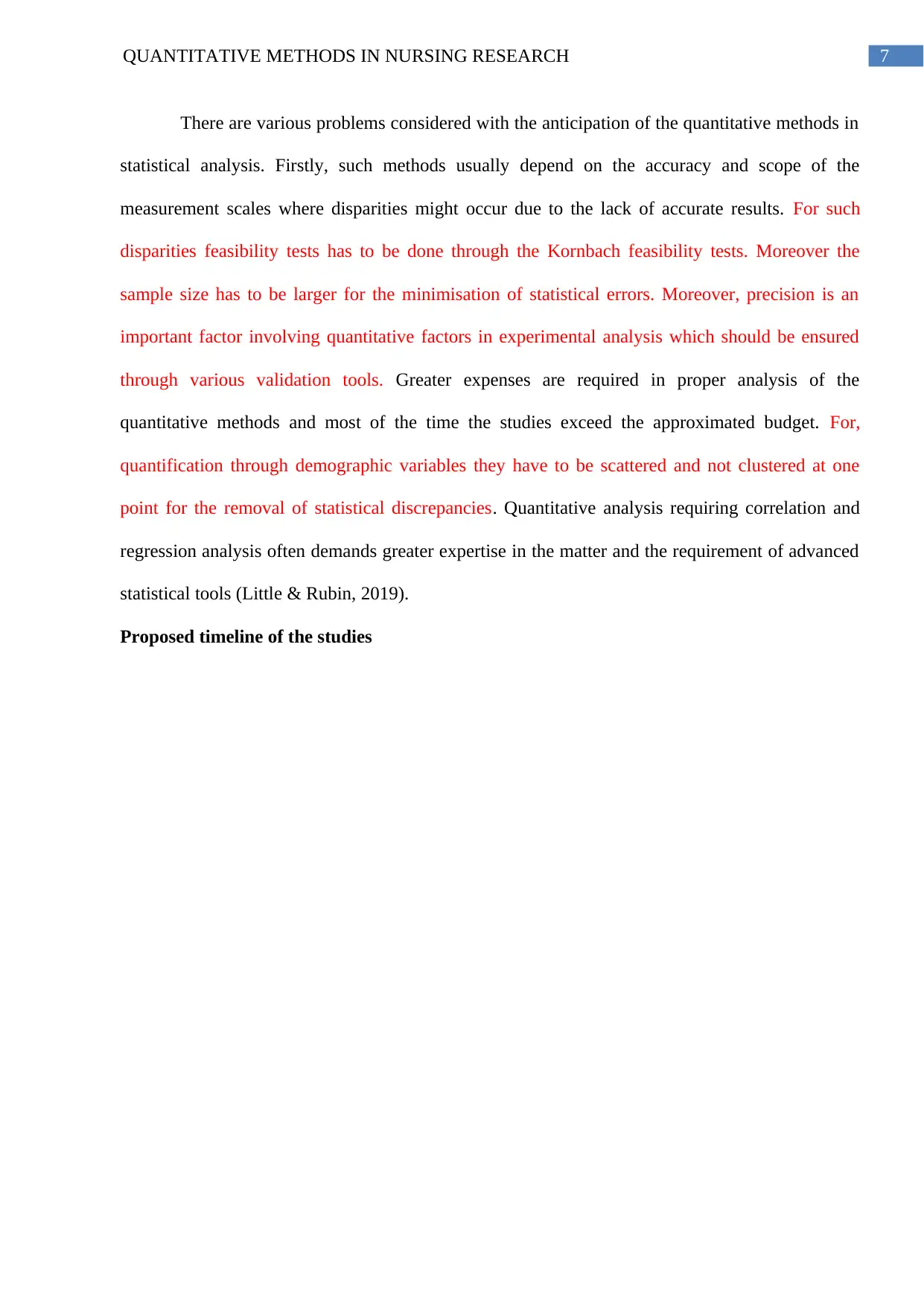
7QUANTITATIVE METHODS IN NURSING RESEARCH
There are various problems considered with the anticipation of the quantitative methods in
statistical analysis. Firstly, such methods usually depend on the accuracy and scope of the
measurement scales where disparities might occur due to the lack of accurate results. For such
disparities feasibility tests has to be done through the Kornbach feasibility tests. Moreover the
sample size has to be larger for the minimisation of statistical errors. Moreover, precision is an
important factor involving quantitative factors in experimental analysis which should be ensured
through various validation tools. Greater expenses are required in proper analysis of the
quantitative methods and most of the time the studies exceed the approximated budget. For,
quantification through demographic variables they have to be scattered and not clustered at one
point for the removal of statistical discrepancies. Quantitative analysis requiring correlation and
regression analysis often demands greater expertise in the matter and the requirement of advanced
statistical tools (Little & Rubin, 2019).
Proposed timeline of the studies
There are various problems considered with the anticipation of the quantitative methods in
statistical analysis. Firstly, such methods usually depend on the accuracy and scope of the
measurement scales where disparities might occur due to the lack of accurate results. For such
disparities feasibility tests has to be done through the Kornbach feasibility tests. Moreover the
sample size has to be larger for the minimisation of statistical errors. Moreover, precision is an
important factor involving quantitative factors in experimental analysis which should be ensured
through various validation tools. Greater expenses are required in proper analysis of the
quantitative methods and most of the time the studies exceed the approximated budget. For,
quantification through demographic variables they have to be scattered and not clustered at one
point for the removal of statistical discrepancies. Quantitative analysis requiring correlation and
regression analysis often demands greater expertise in the matter and the requirement of advanced
statistical tools (Little & Rubin, 2019).
Proposed timeline of the studies
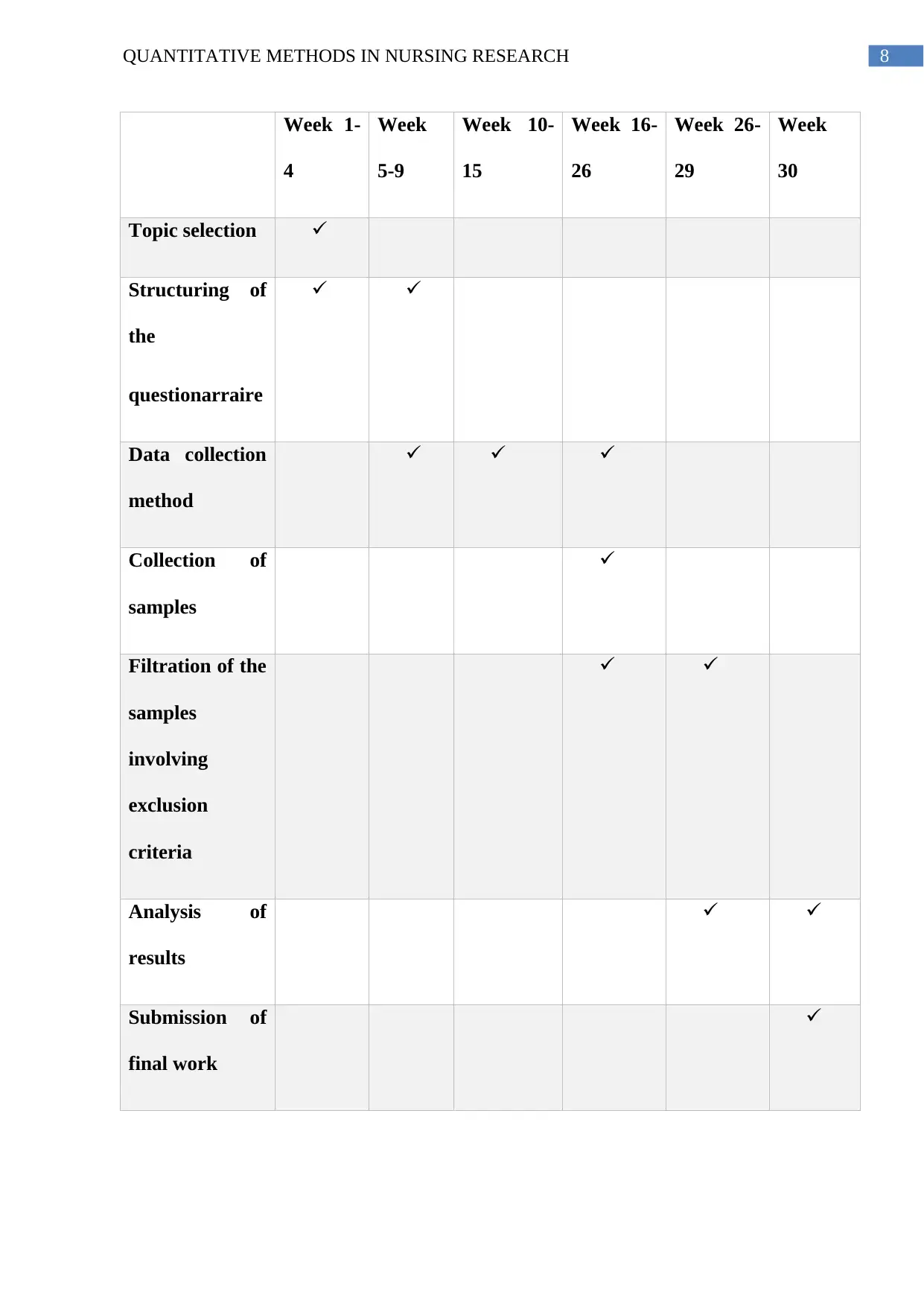
8QUANTITATIVE METHODS IN NURSING RESEARCH
Week 1-
4
Week
5-9
Week 10-
15
Week 16-
26
Week 26-
29
Week
30
Topic selection
Structuring of
the
questionarraire
Data collection
method
Collection of
samples
Filtration of the
samples
involving
exclusion
criteria
Analysis of
results
Submission of
final work
Week 1-
4
Week
5-9
Week 10-
15
Week 16-
26
Week 26-
29
Week
30
Topic selection
Structuring of
the
questionarraire
Data collection
method
Collection of
samples
Filtration of the
samples
involving
exclusion
criteria
Analysis of
results
Submission of
final work
⊘ This is a preview!⊘
Do you want full access?
Subscribe today to unlock all pages.

Trusted by 1+ million students worldwide

9QUANTITATIVE METHODS IN NURSING RESEARCH
Paraphrase This Document
Need a fresh take? Get an instant paraphrase of this document with our AI Paraphraser
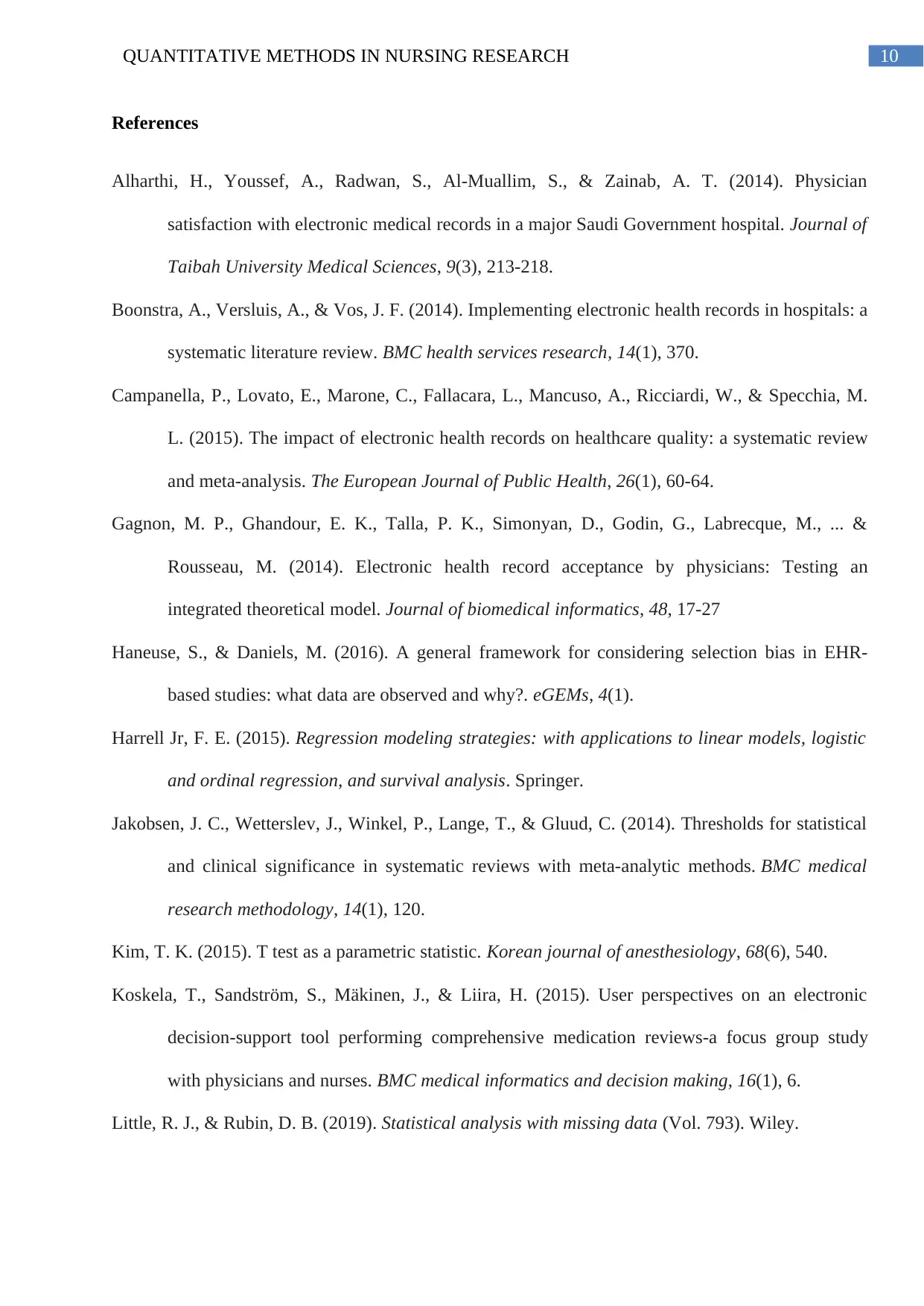
10QUANTITATIVE METHODS IN NURSING RESEARCH
References
Alharthi, H., Youssef, A., Radwan, S., Al-Muallim, S., & Zainab, A. T. (2014). Physician
satisfaction with electronic medical records in a major Saudi Government hospital. Journal of
Taibah University Medical Sciences, 9(3), 213-218.
Boonstra, A., Versluis, A., & Vos, J. F. (2014). Implementing electronic health records in hospitals: a
systematic literature review. BMC health services research, 14(1), 370.
Campanella, P., Lovato, E., Marone, C., Fallacara, L., Mancuso, A., Ricciardi, W., & Specchia, M.
L. (2015). The impact of electronic health records on healthcare quality: a systematic review
and meta-analysis. The European Journal of Public Health, 26(1), 60-64.
Gagnon, M. P., Ghandour, E. K., Talla, P. K., Simonyan, D., Godin, G., Labrecque, M., ... &
Rousseau, M. (2014). Electronic health record acceptance by physicians: Testing an
integrated theoretical model. Journal of biomedical informatics, 48, 17-27
Haneuse, S., & Daniels, M. (2016). A general framework for considering selection bias in EHR-
based studies: what data are observed and why?. eGEMs, 4(1).
Harrell Jr, F. E. (2015). Regression modeling strategies: with applications to linear models, logistic
and ordinal regression, and survival analysis. Springer.
Jakobsen, J. C., Wetterslev, J., Winkel, P., Lange, T., & Gluud, C. (2014). Thresholds for statistical
and clinical significance in systematic reviews with meta-analytic methods. BMC medical
research methodology, 14(1), 120.
Kim, T. K. (2015). T test as a parametric statistic. Korean journal of anesthesiology, 68(6), 540.
Koskela, T., Sandström, S., Mäkinen, J., & Liira, H. (2015). User perspectives on an electronic
decision-support tool performing comprehensive medication reviews-a focus group study
with physicians and nurses. BMC medical informatics and decision making, 16(1), 6.
Little, R. J., & Rubin, D. B. (2019). Statistical analysis with missing data (Vol. 793). Wiley.
References
Alharthi, H., Youssef, A., Radwan, S., Al-Muallim, S., & Zainab, A. T. (2014). Physician
satisfaction with electronic medical records in a major Saudi Government hospital. Journal of
Taibah University Medical Sciences, 9(3), 213-218.
Boonstra, A., Versluis, A., & Vos, J. F. (2014). Implementing electronic health records in hospitals: a
systematic literature review. BMC health services research, 14(1), 370.
Campanella, P., Lovato, E., Marone, C., Fallacara, L., Mancuso, A., Ricciardi, W., & Specchia, M.
L. (2015). The impact of electronic health records on healthcare quality: a systematic review
and meta-analysis. The European Journal of Public Health, 26(1), 60-64.
Gagnon, M. P., Ghandour, E. K., Talla, P. K., Simonyan, D., Godin, G., Labrecque, M., ... &
Rousseau, M. (2014). Electronic health record acceptance by physicians: Testing an
integrated theoretical model. Journal of biomedical informatics, 48, 17-27
Haneuse, S., & Daniels, M. (2016). A general framework for considering selection bias in EHR-
based studies: what data are observed and why?. eGEMs, 4(1).
Harrell Jr, F. E. (2015). Regression modeling strategies: with applications to linear models, logistic
and ordinal regression, and survival analysis. Springer.
Jakobsen, J. C., Wetterslev, J., Winkel, P., Lange, T., & Gluud, C. (2014). Thresholds for statistical
and clinical significance in systematic reviews with meta-analytic methods. BMC medical
research methodology, 14(1), 120.
Kim, T. K. (2015). T test as a parametric statistic. Korean journal of anesthesiology, 68(6), 540.
Koskela, T., Sandström, S., Mäkinen, J., & Liira, H. (2015). User perspectives on an electronic
decision-support tool performing comprehensive medication reviews-a focus group study
with physicians and nurses. BMC medical informatics and decision making, 16(1), 6.
Little, R. J., & Rubin, D. B. (2019). Statistical analysis with missing data (Vol. 793). Wiley.

11QUANTITATIVE METHODS IN NURSING RESEARCH
⊘ This is a preview!⊘
Do you want full access?
Subscribe today to unlock all pages.

Trusted by 1+ million students worldwide
1 out of 12
Related Documents
Your All-in-One AI-Powered Toolkit for Academic Success.
+13062052269
info@desklib.com
Available 24*7 on WhatsApp / Email
![[object Object]](/_next/static/media/star-bottom.7253800d.svg)
Unlock your academic potential
Copyright © 2020–2025 A2Z Services. All Rights Reserved. Developed and managed by ZUCOL.





